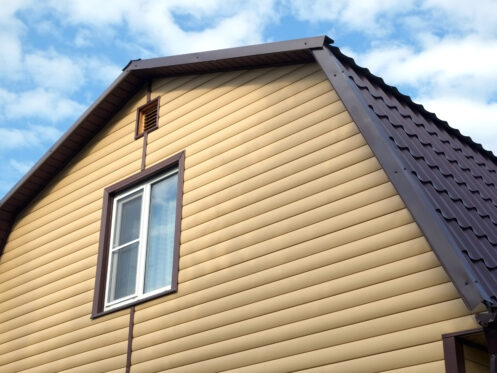If you’re interested in sustainable living, it’s important to pay close attention to the components of your home. The materials and type of roof you choose can have a big impact on your energy usage, carbon footprint, and overall eco-friendliness. Fortunately, it’s very easy to pick a roof that makes a difference. There are a lot of great eco-friendly products on the market that help homeowners protect the environment while enjoying a beautiful home.
Wood Shingles
This classic option has been around for centuries, yet it remains one of the most sustainable roofing materials today. Unlike some synthetic roofing materials, wood shingles are made from renewable resources. Most modern wood shingles are made from fast-growing trees purposefully grown for roof production. However, there are some especially eco-friendly options that reduce waste by using reclaimed wood from buildings or wood scraps from trees cut down for lumber.
Another advantage of wood shingles is that they typically don’t include a lot of toxic byproducts. Most wood shingles can be produced without pollution or excessive greenhouse gases. Even after they reach the end of their lifespan, wood shingles continue to be a green option. They degrade naturally over time instead of taking up space in landfills forever, and the wood can even be recycled into things like mulch, insulation, or fuel.
Metal Roofs
Metal roofing is a sustainable option due to its extreme durability and longevity. Metal is a lightweight material that can withstand everything from extreme weather to fire, and it naturally lasts around three times as long as other roofing options. By cutting back on the number of times you need to replace your roof, metal roofs let you reduce waste and consume fewer materials overall.
Furthermore, metal is one of the most versatile materials. You can get roofs made from already recycled metal. At the end of its life, your roof can be recycled into other materials. Some types of metal roofs are made of such useful metals that manufacturers will even pay you for your roof scraps once it’s time to get a new roof. Another thing to consider is that metal roofs are typically very reflective. With the right coating and color, a metal roof can reflect large amounts of UV rays. This helps to keep your home cool, so it lowers the amount of energy you need to run your air conditioner.
Clay Tiles
Clay tiles are roofing materials formed by baking clay into interlocking tiles. Their unique shape and thick material provide many benefits for homeowners. The clay itself is quite insulating, so it can help to keep your home temperatures more stable. At the same time, the barrel shape of these tiles allows air to circulate better than flat, overlapping shingles. This lets hot air rise instead of trapping it in your home.
The production method for clay tiles is also quite sustainable. These tiles are made from sand, water, and other natural resources. They don’t require toxic byproducts or petroleum-based ingredients to produce. The raw materials from clay tiles can even be used to create new clay tiles once your roof reaches the end of its lifespan.
Slate Roofs
Slate roofs are made from overlapping tiles or shingles cut from pieces of rock. While most people choose slate due to its charming, traditional appearance, this roofing material is also popular among those who prioritize sustainability. Slate is one of the most durable roofing materials out there. A properly installed slate roof can easily last more than 100 years, so it reduces the need for more materials over the years.
The other big perk of a slate roof is that it is a natural insulator. As a type of rock, slate is extremely dense and does not transfer energy easily. This allows you to reduce your energy usage at home and avoid having to spend as much power to run your HVAC system.
Fiber Cement Roofs
Fiber cement is a newer form of roofing material that is gaining fans among green living experts. This unusual material is made by blending cement and other bonding agents with strands of fiber. Compared to more traditional roofing methods, the production of fiber cement uses less energy and allows the incorporation of more recyclable materials. The inclusion of fiber also makes these roof tiles lighter and easier to install than slate or clay.
Fiber cement roofs are quite durable. Compared to materials like wood, they are more resistant to rotting or insect damage. They can last up to 50 years, so they require less frequent replacement than many asphalt roofs. While this unconventional material isn’t as common, it has quite a few perks for homeowners who prioritize eco-friendliness.
Cool Roofs
If you prioritize sustainability, you might also want to consider the overall design of your roof. Cool roofs are made from multiple types of materials, but the one thing they all have in common is that they are engineered to reduce cooling costs. These roofs often consist of layers of insulating materials topped with a reflective surface. Cool roofs tend to be paler colors and have a smoother surface, but they’re often indistinguishable from a traditional roof in appearance.
Cool roofs are very popular among homeowners looking to make southern living more sustainable. Their design prevents your home from absorbing as much heat from the sun, so it stays cooler overall. Without direct UV rays heating up your home, you don’t have to spend as much time and energy running your HVAC system. In areas with long summers, a cool roof can reduce energy consumption by up to 20%.
Solar Roofs
Of course, no guide to sustainable roofing would be complete without mentioning solar roofs. Solar roofs incorporate solar panels into their designs. There are many types of solar roofs, ranging from flat panels mounted on top of traditional shingles to curved tiles that slot into place among your roofing tiles. The main thing all these roofs have in common is that the tiles collect energy from the sun and convert it into electricity for homeowners to use.
Solar roofs are one of the best ways to make your entire lifestyle more sustainable. Once they’re in place, you get clean, renewable energy straight from the sun. Unlike normal forms of electricity, solar roofs do not require burning fuels and producing greenhouse gases. Furthermore, they don’t need non-renewable resources. Instead, you can always count on them to provide you with a renewable and waste-free form of energy.
Eco-friendly roofs come in a variety of styles. Some types of roofs are useful due to their sustainable and recyclable materials, and others change your energy consumption levels and help you avoid waste. To find the perfect roof design for your home, turn to Fraser Roofing, LLC.
Our team of roofing experts is happy to consult with you and recommend eco-friendly options. We also help Atlanta and central Georgia residents with a variety of other roofing services like roofing estimates, repairs, and roofing installations. Contact Fraser Roofing, LLC to learn more about our roofing options.

